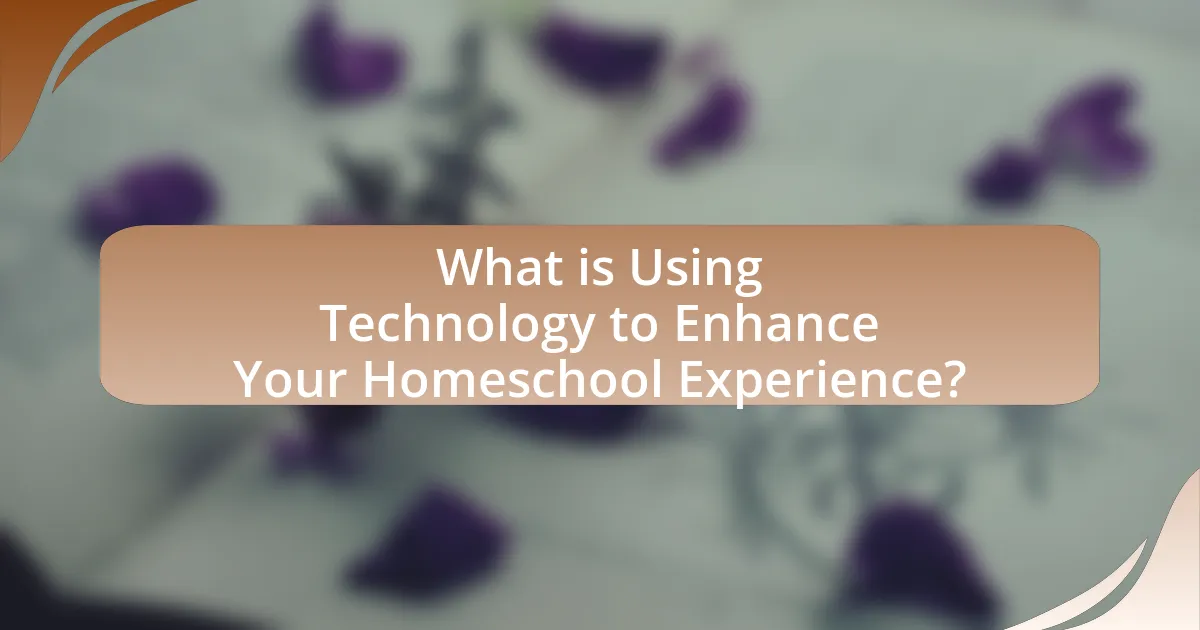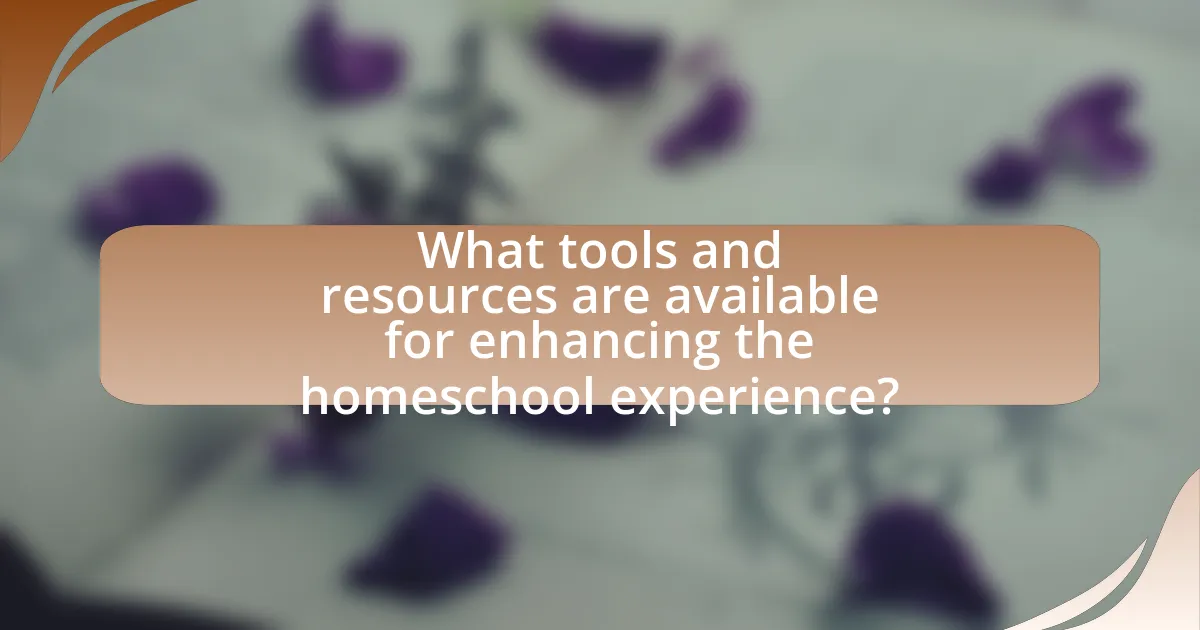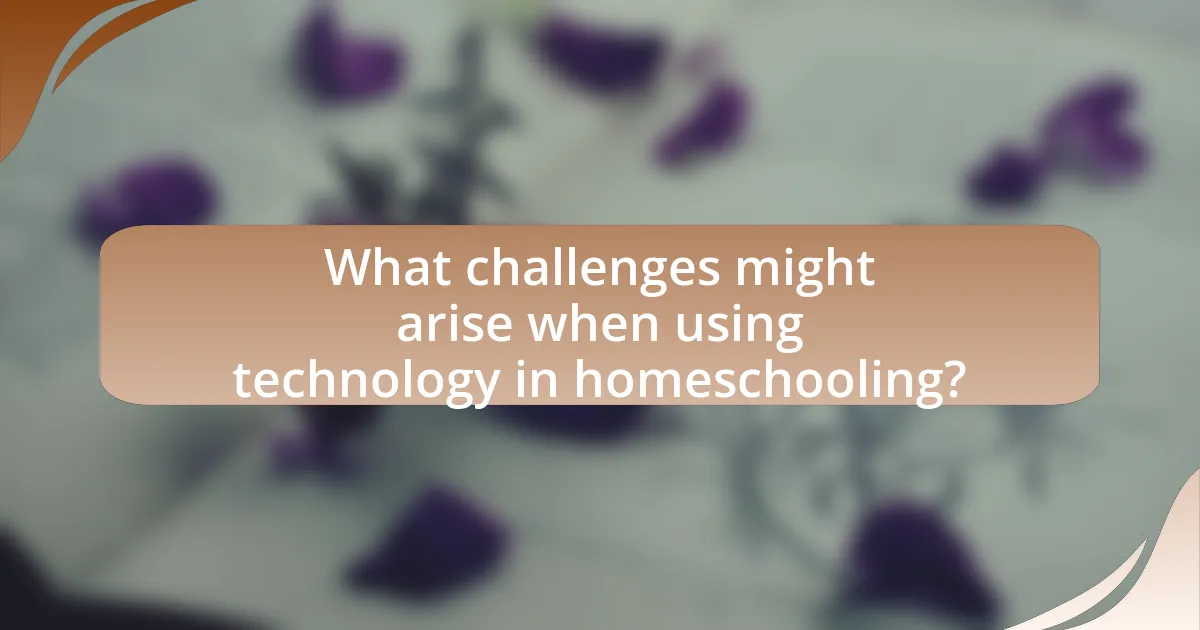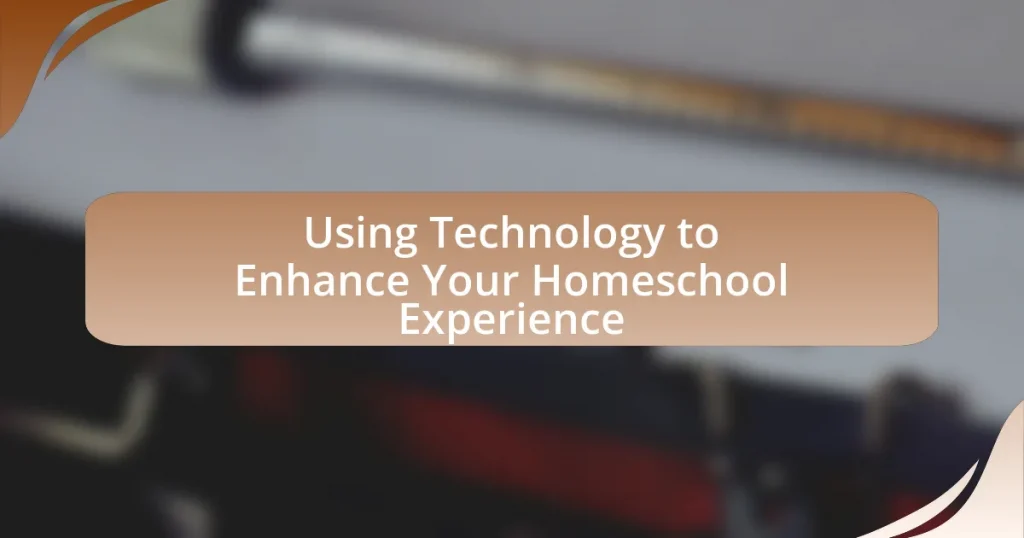The article focuses on using technology to enhance the homeschooling experience by integrating digital tools and resources that improve learning outcomes and engagement. It discusses various methods for incorporating technology, such as online learning platforms, educational apps, and virtual communication tools, which cater to different learning styles and promote personalized learning. The article also highlights the benefits of technology in homeschooling, including increased student engagement, access to diverse resources, and effective progress tracking. Additionally, it addresses potential challenges and best practices for utilizing technology effectively in a homeschool setting.

What is Using Technology to Enhance Your Homeschool Experience?
Using technology to enhance your homeschool experience involves integrating digital tools and resources to improve learning outcomes and engagement. This can include utilizing online educational platforms, interactive software, and virtual classrooms that provide access to a wide range of subjects and materials. For instance, studies show that students who use technology in their learning process demonstrate higher retention rates and improved critical thinking skills. Additionally, resources like educational apps and online tutoring services can offer personalized learning experiences, catering to individual student needs and learning paces.
How can technology be integrated into homeschooling?
Technology can be integrated into homeschooling through the use of online learning platforms, educational apps, and digital resources. Online learning platforms like Khan Academy and Coursera provide structured courses that cover various subjects, allowing students to learn at their own pace. Educational apps, such as Duolingo for language learning or Prodigy for math, offer interactive and engaging ways to reinforce concepts. Additionally, digital resources like e-books and online libraries expand access to a wide range of materials, enhancing the curriculum. Research indicates that technology in education can improve student engagement and learning outcomes, as evidenced by a study published in the Journal of Educational Psychology, which found that students using digital tools showed higher achievement levels compared to traditional methods.
What types of technology are most effective for homeschooling?
The most effective types of technology for homeschooling include online learning platforms, educational apps, and virtual communication tools. Online learning platforms, such as Khan Academy and Coursera, provide structured courses and resources that cater to various subjects and grade levels, allowing students to learn at their own pace. Educational apps, like Duolingo and Quizlet, offer interactive and engaging ways to reinforce learning through gamification and quizzes. Virtual communication tools, such as Zoom and Google Classroom, facilitate real-time interaction between students and teachers, enabling collaborative learning experiences. These technologies enhance the homeschooling experience by providing diverse resources, fostering engagement, and promoting effective communication.
How does technology support different learning styles in homeschooling?
Technology supports different learning styles in homeschooling by providing diverse tools and resources tailored to individual preferences. For instance, visual learners benefit from video tutorials and interactive simulations, while auditory learners can engage with podcasts and audiobooks. Kinesthetic learners utilize educational apps that promote hands-on activities and experiments. Research indicates that incorporating technology in education can enhance engagement and retention; a study by the U.S. Department of Education found that students using technology for personalized learning showed improved academic performance. This evidence underscores the effectiveness of technology in accommodating various learning styles within a homeschooling framework.
What are the benefits of using technology in homeschooling?
The benefits of using technology in homeschooling include personalized learning, access to diverse resources, and enhanced engagement. Personalized learning allows students to progress at their own pace, tailoring educational experiences to individual needs. Access to diverse resources, such as online courses, educational apps, and virtual libraries, expands learning opportunities beyond traditional textbooks. Enhanced engagement is achieved through interactive tools and multimedia content, which can make learning more enjoyable and effective. Studies show that technology integration in education can lead to improved academic performance and increased motivation among students.
How does technology improve student engagement in homeschool settings?
Technology improves student engagement in homeschool settings by providing interactive and personalized learning experiences. Digital tools such as educational apps, online courses, and virtual classrooms allow students to learn at their own pace, catering to individual learning styles. For instance, a study by the U.S. Department of Education found that students who used technology for personalized learning showed increased motivation and engagement compared to traditional methods. Additionally, technology facilitates access to a vast array of resources, including videos, simulations, and collaborative platforms, which enhance understanding and retention of information.
What role does technology play in personalized learning for homeschoolers?
Technology plays a crucial role in personalized learning for homeschoolers by providing tailored educational resources and adaptive learning platforms. These tools enable parents and students to customize the learning experience according to individual needs, preferences, and learning paces. For instance, platforms like Khan Academy and IXL offer personalized learning paths that adjust based on student performance, allowing for targeted skill development. Research indicates that personalized learning can lead to improved student engagement and academic outcomes, as evidenced by a study from the Bill & Melinda Gates Foundation, which found that personalized learning approaches can significantly enhance student achievement in various subjects.

What tools and resources are available for enhancing the homeschool experience?
Various tools and resources are available to enhance the homeschool experience, including online learning platforms, educational apps, and virtual tutoring services. Online platforms like Khan Academy and Coursera offer structured courses across subjects, while educational apps such as Duolingo and Quizlet provide interactive learning experiences. Additionally, virtual tutoring services like Wyzant and Tutor.com connect students with qualified educators for personalized assistance. These resources support diverse learning styles and can significantly improve educational outcomes in a homeschool setting.
What online platforms can support homeschooling?
Online platforms that can support homeschooling include Khan Academy, Coursera, and Outschool. Khan Academy offers a comprehensive range of free courses across various subjects, making it a valuable resource for students of all ages. Coursera provides access to courses from top universities and institutions, allowing learners to explore advanced topics and earn certificates. Outschool specializes in live, interactive classes taught by experienced educators, covering unique subjects that may not be available in traditional curricula. These platforms collectively enhance the homeschooling experience by providing diverse educational resources and flexible learning options.
How do educational apps enhance learning in a homeschool environment?
Educational apps enhance learning in a homeschool environment by providing personalized learning experiences tailored to individual student needs. These apps often utilize adaptive learning technologies that assess a student’s progress and adjust the difficulty of tasks accordingly, ensuring that learners remain engaged and challenged. For instance, a study published in the Journal of Educational Psychology found that students using adaptive learning software showed a 30% improvement in math skills compared to traditional methods. Additionally, educational apps offer interactive content, such as videos and quizzes, which can increase retention and understanding of complex subjects. This interactive approach caters to various learning styles, making education more accessible and effective for homeschoolers.
What are the best websites for homeschooling resources?
The best websites for homeschooling resources include Khan Academy, which offers free online courses and instructional videos across various subjects; Education.com, providing worksheets and lesson plans; and Homeschool.com, a comprehensive directory of resources and support for homeschooling families. These platforms are widely recognized for their quality content and user-friendly interfaces, making them valuable tools for enhancing the homeschooling experience.
How can parents effectively use technology to track progress?
Parents can effectively use technology to track progress by utilizing educational apps and online platforms that provide real-time data on student performance. These tools often include features such as grade tracking, assignment completion status, and skill assessments, allowing parents to monitor their child’s learning journey closely. For instance, platforms like Google Classroom and Edmodo enable parents to view assignments and feedback, while apps like ClassDojo facilitate communication between parents and educators. Research indicates that consistent use of such technology can lead to improved student outcomes, as parents who engage with these tools are better informed about their child’s academic needs and can provide timely support.
What tools are available for assessing student performance in homeschooling?
Various tools are available for assessing student performance in homeschooling, including standardized tests, online assessment platforms, and educational software. Standardized tests, such as the Iowa Test of Basic Skills, provide a benchmark for evaluating student progress against national norms. Online assessment platforms like Khan Academy and IXL offer interactive quizzes and progress tracking, allowing parents to monitor learning outcomes in real-time. Additionally, educational software such as Google Classroom facilitates assignment submissions and feedback, enhancing the assessment process. These tools collectively enable parents to effectively gauge their child’s academic performance and tailor their homeschooling approach accordingly.
How can technology facilitate communication between parents and students?
Technology facilitates communication between parents and students by providing various platforms and tools that enable real-time interaction and information sharing. For instance, educational apps and online learning management systems allow parents to monitor their child’s progress, access assignments, and communicate directly with teachers. Research indicates that 70% of parents feel more engaged in their child’s education when using digital communication tools, highlighting the effectiveness of technology in bridging the gap between home and school. Additionally, video conferencing tools enable face-to-face discussions, fostering a collaborative learning environment that supports student success.

What challenges might arise when using technology in homeschooling?
Challenges that might arise when using technology in homeschooling include issues related to access, distraction, and the need for parental involvement. Limited access to reliable internet or devices can hinder students’ ability to engage with online resources effectively. Additionally, the presence of various digital distractions, such as social media and games, can reduce focus and productivity during learning sessions. Furthermore, parents may need to invest significant time and effort to facilitate technology use, ensuring that their children remain on task and understand the material, which can be demanding for those balancing multiple responsibilities.
What are common technical issues faced by homeschooling families?
Common technical issues faced by homeschooling families include unreliable internet connectivity, inadequate access to educational software, and difficulties with online learning platforms. Unreliable internet can disrupt lessons and limit access to resources, affecting the overall learning experience. Inadequate access to educational software may hinder the ability to utilize interactive tools that enhance learning. Additionally, difficulties with online learning platforms can lead to frustration and reduced engagement, as families may struggle with navigation or technical glitches. These issues highlight the importance of reliable technology in supporting effective homeschooling.
How can families troubleshoot technology problems in homeschooling?
Families can troubleshoot technology problems in homeschooling by systematically identifying the issue, checking connections, and utilizing online resources. First, families should define the specific problem, such as internet connectivity or software issues. Next, they can check physical connections, like cables and power sources, to ensure everything is properly set up. If the problem persists, families can consult online resources, including forums, instructional videos, and troubleshooting guides provided by software or hardware manufacturers. According to a study by the National Center for Education Statistics, 95% of households with school-age children have access to the internet, making online troubleshooting resources widely available and effective for resolving common technology issues.
What strategies can be employed to minimize distractions from technology?
To minimize distractions from technology, individuals can implement strategies such as setting specific time blocks for technology use, utilizing apps that limit access to distracting websites, and creating a dedicated workspace free from non-essential devices. Research indicates that structured schedules enhance focus; for instance, a study published in the Journal of Educational Psychology found that students who used time management techniques reported higher productivity levels. Additionally, using website blockers can reduce the temptation to engage with distracting content, as evidenced by a report from the American Psychological Association, which highlights that limiting access to distractions can significantly improve concentration and task completion rates.
How can parents ensure a balanced approach to technology use in homeschooling?
Parents can ensure a balanced approach to technology use in homeschooling by setting clear guidelines and limits on screen time. Research indicates that excessive screen time can negatively impact children’s physical and mental health, with the American Academy of Pediatrics recommending no more than one hour of high-quality programming for children aged 2 to 5 years and consistent limits for older children. Parents should also incorporate a variety of learning methods, blending technology with hands-on activities, outdoor learning, and face-to-face interactions to promote a well-rounded educational experience. By regularly assessing their children’s engagement and well-being, parents can adjust technology use to maintain a healthy balance that supports both academic success and personal development.
What guidelines should be followed for screen time in homeschooling?
Guidelines for screen time in homeschooling include limiting daily screen use to no more than one to two hours for children aged 2 to 5 years, and ensuring that older children engage in no more than two hours of recreational screen time per day. The American Academy of Pediatrics emphasizes the importance of balancing screen time with other activities, such as physical play and face-to-face interactions. Additionally, parents should prioritize educational content and co-viewing to facilitate discussions about what children are watching, thereby enhancing learning outcomes. Regular breaks from screens are also recommended to prevent fatigue and promote overall well-being.
How can parents encourage offline learning alongside technology use?
Parents can encourage offline learning alongside technology use by integrating hands-on activities, such as arts and crafts, outdoor exploration, and reading physical books into their children’s daily routines. Research indicates that experiential learning enhances cognitive development and retention of information, making offline activities essential for a balanced education. For instance, a study published in the journal “Child Development” found that children who engage in hands-on learning demonstrate improved problem-solving skills and creativity compared to those who rely solely on digital resources. By setting specific times for offline activities and creating a structured environment that values both technology and traditional learning methods, parents can foster a well-rounded educational experience.
What are some best practices for using technology in homeschooling?
Best practices for using technology in homeschooling include integrating interactive learning tools, utilizing online resources for diverse subjects, and establishing a structured schedule. Interactive learning tools, such as educational apps and games, engage students and enhance retention of information. Online resources, including virtual libraries and educational websites, provide access to a wide range of materials that cater to different learning styles. A structured schedule helps maintain consistency and discipline, ensuring that students stay focused and organized in their studies. These practices are supported by research indicating that technology can improve student engagement and learning outcomes when used effectively.
How can parents create a tech-friendly learning environment at home?
Parents can create a tech-friendly learning environment at home by establishing dedicated spaces for technology use, ensuring reliable internet access, and integrating educational software and tools. Designating specific areas for learning minimizes distractions and promotes focus, while high-speed internet is essential for accessing online resources and participating in virtual classes. Furthermore, incorporating educational apps and platforms, such as Khan Academy or Google Classroom, enhances the learning experience by providing interactive and engaging content. Research indicates that structured tech use can improve academic performance and foster digital literacy skills, which are crucial in today’s educational landscape.
What tips can help maximize the effectiveness of technology in homeschooling?
To maximize the effectiveness of technology in homeschooling, parents should integrate interactive tools and resources that cater to diverse learning styles. Utilizing platforms like educational apps, online courses, and virtual classrooms can enhance engagement and understanding. Research indicates that interactive learning environments improve retention rates; for instance, a study by the University of California found that students using interactive technology scored 20% higher on assessments compared to traditional methods. Additionally, establishing a structured schedule that incorporates technology can help maintain focus and discipline, ensuring that educational goals are met efficiently.










